The previous Director of Archives and Research, Dr. Harold Hunter, shared the history of the IPHC in Oklahoma on two posts:
Early IPHC and Classical Pentecostalism in Oklahoma
I have also established a new partnership with the Oklahoma History Center, and I will share the link to our digital partnership asap (hopefully by December 2024). On this new digital partnership are 72 items from the archives that relate to Oklahoma history. This is only the beginning. There are many more!
Here are Dr. Hunter’s posts:
Early IPHC and Classical Pentecostalism in ‘Oklahoma’
Writing about a spiritual encounter in 1895, B.H. Irwin—founder of early IPHC known as the Fire-Baptized Holiness Association—said, “I was out in Oklahoma in a sod house about 10 or 11 o’clock” and “Praise God forever and ever,” I got the “real experience of the baptism of fire” because I felt “that I was literally on fire.” “For five hours I felt that I should certainly be consumed.” “My fingertips were even hot and seemed to burn in the manifest presence of the in-working Diety.” “It makes me feel good when I think that the Spirit has free access to my soul, bless His name forever and ever!” Eager to tell others about this, Irwin published a tract titled “Red Hot Holiness”!
Irwin returned to Indian Territory in 1897 and organized a Fire-Baptized Holiness Association in El Reno. While in Oklahoma Territory, he wrote:
Oh the fire, the blessed fire!
How it blazes, burns and glows,
Leaping, dashing, rising higher,
The more severe the north wind blows.
Irwin was followed in leadership in 1900 by J.H. King, a graduate of the U.S. Grant University School of Theology in Chattanooga, Tennessee. King’s first trip to Oklahoma was to Lamont in 1902 when the FBHA held their national meeting and changed their name to the Fire Baptized Holiness Church. In 1905, King conducted a revival in Snyder, Oklahoma Territory. Not long after he left, a large section of the town was blown away in a tornado.
The first Pentecostal meeting held in Oklahoma Territory was hosted by the FBHC in Lamont, OK late in 1906 with Glenn Cook from the Azusa St. Revival. [See below “Pentecost in Lamont, Okla” by Glenn Cook, The Apostolic Faith 1:5 (January 1907)]. A larger meeting was held in Lamont the next year under the leadership of J.H. King that included Glenn Cook and GB Cashwell. Lamont at this time was a thriving community with a hotel thanks in no little part to the Railroad.
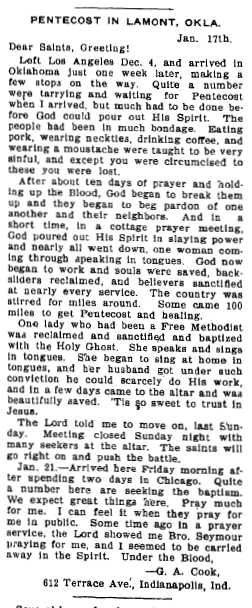
LH Wentz published an article in the Apostolic Evangel 1:18 (11/1/1909, p. 5) where he explained that the FBHA church in Lamont started in his home in 1899. By 1902, the Lamont FBHC had a church and a parsonage. Wentz had traveled 62 miles to hear the FBH message after reading about BH Irwin in The Way of Faith.
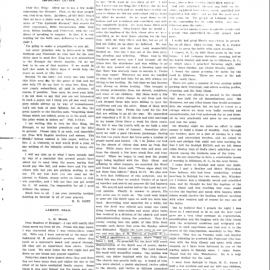
Wentz Apostolic Evangel Article. Click the image for larger view.
In 1909 Henry P. Lott—who had a house on Westlawn Street in downtown Oklahoma City—was appointed FBHC Ruling Elder for Oklahoma and the next year he organized the Blue Front Saloon Mission into the First FBHC of Oklahoma City. He had already opened a Rescue Home in downtown Oklahoma City. About this same time, FBHC leader Daniel Awrey took charge of the Emmanuel Bible School in Beulah, OK which produced many members for what is now IPHC. In 1911, Agnes Ozman LaBerge, designated by some USA historians as the first ‘Pentecostal’ of the 20th Century joined the FBHC in Oklahoma centering her ministry in Perry, OK.
Miss Mattie Mallory, an 1889 graduate of Baker University, accepted briefly in 1897 the superintendency of a Fire-Baptized Mission in Winnipeg. Having changed trains in Oklahoma City while enroute to the Canadian assignment and sensing a call to minister to homeless children there, she quickly responded in August to an invitation from Reuben E. Hershey to conduct a school for orphans and children of evangelists in conjunction with the mission and home he recently had opened on Reno Street in downtown Oklahoma City.
By 1909 Miss Mallory moved her orphanage and rescue home from Beulah Heights to Bethany, OK which is also the present location of the IPHC headquarters. She was joined in this effort by C.B. Jernigan who shaped the new town’s charter that sought to achieve holiness ideas of moral and civic righteousness.
Miss Mallory had 200 acres designed to use agricultural enterprises to enable the orphanage to be self-sustaining. Her efforts at starting a school evolved into what is now Southern Nazarene University, which occupies land dialogically across 39th Expressway. In 1975, the Children’s Convalescent Center of Bethany, successor to the Oklahoma Orphanage, was placed under the custody of the IPHC. In an act of resolute generosity, the IPHC released the Children’s Center and granted it sovereignty in 1990s.
The recent photos below were taken by David Parker from a 2016 visit to Lamont, OK, with Jesse Heath and myself that shows the original FBHC building that is now used by civic organizations. The photos of Lamont from the era depicted in this article were taken from Ardis Gautier, A Place Called Home: The History of Lamont, Oklahoma: 1893 to 1993.
Dr. Harold D. Hunter
Director
IPHC Archives & Research Center
Headlines from the West
By Dr. Harold D. Hunter
Director of the IPHC Archives & Research Center
Although some secondary sources portray the International Pentecostal Holiness Church presence in the West as a southern transplant, previously lost original sources tell a quite different story. This is aptly illustrated in the rapid ascent of B.H. Irwin on the national stage chronicled in The Way of Faith, The Christian Witness and Advocate of Bible Holiness, and like papers.
Evangelistic work for the Wesleyan Methodist Church brought Irwin to Enid, Oklahoma Territory, where in 1895 he reports his “baptism with fire”. Irwin’s tantalizing account in Live Coals of Fire starts with “a cross of pure transparent fire” which is followed two days later by a physical sensation of heat.
Irwin spreads the fire-message to states in the West and South but the first Fire-Baptized Holiness state association was organized September 1896/7 in Olmitz, Iowa. Next would be Mound Valley, Kansas then Oklahoma Territory and Texas, all in 1897. The FBH hymnal Blood and Fire Songs put together by C.T. Stevens was published in Missouri about the same time. The hymnal includes songs written by Irwin himself.
Miss Mattie Mallory, a FBHA devotee, commenced work in Oklahoma City in 1897 and the next year launched a periodical called The Guide. Miss Mallory moved from Beulah Heights in 1907 and with C.B. Jernigan shaped the town charter of Bethany. Her work in time would evolve and be seen as the start of Southern Nazarene University and the Children’s Center. In 1975, the IPHC would locate their headquarters in Bethany.
FBHA state associations took shape first in the West then the South and Canada so Irwin brought them together at Anderson, South Carolina in the summer of 1898 for the First General Council of the Fire-Baptized Holiness Association. Ruling Elders appointed by General Overseer B.H. Irwin included: Oklahoma – J.M. Henson; Kansas – J.L. Wolford; Texas – Allen Hodges; Iowa – Oliver Fluke; Ontario – A.E. Robinson. Within a year, Ruling Elders would be in place at Arkansas, Manitoba, Michigan, Mississippi, Missouri, and Nebraska.
In October 1899, the first issue of Live Coals of Fire came off the FBHA presses in Lincoln, Nebraska. Called the first FBHA missionary by Irwin, John Dull, who joined the Iowa FBHA state association in 1896/7 and successfully advanced the cause there, published plans in Live Coals of Fire to reach Havana, Cuba by January 12, 1900. L.H. Wentz wrote in a 1909 issue of The Apostolic Evangel that he opened a FBHA local church in his home in Lamont, Oklahoma 10 years earlier. Three years later they erected a proper church building then a two-room parsonage. Wentz learned about the FBHA by reading The Way of Faith then attending a FBHA camp meeting 62 miles from his home.
J.H. King was chosen General Overseer at the 1900 FBHA General Council in Olmitz, Iowa. King had been serving as FBHA Ruling Elder of Ontario and pastor in Toronto. The Ruling Elders were male and female, black and white. As late as June, the final issue of Live Coals of Fire showed 140 full time evangelists scattered over twenty-three states or territories and in two Canadian provinces.
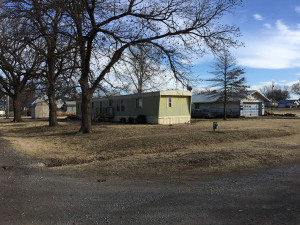
Original Location of the Fire-Baptized Holiness Church on the corner of Linn and Washington in Lamont, Oklahoma.
The Fourth General Council of Fire-Baptized Holiness Association was held at Lamont, Oklahoma in October 1902. Reflecting a development in ecclesiology, the name was changed from the Fire-Baptized Holiness Association to Fire-Baptized Holiness Church. FBHC General Overseen King visited a group in Snyder, Oklahoma in 1905 after which the town was virtually leveled by a tornado. Oliver Fluke is named in the initial FBHC charter of the same year with an address in Kiowa County, Oklahoma Territory.
In December 1906, Glenn Cook brought the Azusa St. Revival message to the FBH congregation in Lamont, Oklahoma. This was the first such event for Oklahoma. According to The Apostolic Faith, B.H. Irwin spoke in tongues at a mission in Salem, Oregon. That same year, Emmanuel’s Bible School was established in Beulah Home, Doxey, Oklahoma where Daniel Awrey would serve as principal. This school produced early leaders for the IPHC in Oklahoma. While in Ohio, Awrey had first spoken in tongues in 1890 and previously served as FBHA Ruling Elder in Tennessee. Awrey made his mark at the Azusa St. Mission in Los Angeles and was featured at the Pentecostal world conference convened by Vicar Alexander Boddy at Sunderland, England. In 1910/11, Awrey was in India with Azusa St. pioneer Frank Bartleman but by 1913 was overcome by malaria in Liberia.
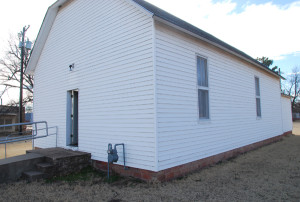
Outside of what is thought to be the building that housed the Fire-Baptized Holiness Church congregation in Lamont, Oklahoma.
The Apostolic Evangel advertised meetings in Lamont for May 10 to 30, 1907,
featuring Glenn Cook, J.H. King and G.B. Cashwell. Glen Cook is identified as having been baptized in the Holy Spirit in the Los Angeles Revival and adds that he “speaks in different languages as the Spirit gives utterance”. The proposed themes included baptism with the Holy Ghost, evidenced by speaking with tongues as on the day of Pentecost. Also emphasized was “healing of the body as in the Apostolic Church”.
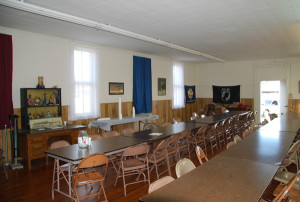
Inside of what is thought to be the building that housed the Fire-Baptized Holiness Church congregation in Lamont, Oklahoma.
In 1908, both The Apostolic Evangel and Bridegroom’s Messenger carry appeals by Harry Lott seeking support for his rescue mission for women in Oklahoma City. The following year F.M. Britton formally reorganized the FBHC in Oklahoma with only one local church, Lamont. Harry Lott was appointed Ruling Elder and the next month Lott’s Blue Front Saloon Mission became the first FBHC local church in Oklahoma City.

A 1929 Plat map, warranty deeds from July 8, 1901 and May 24, 1910, and a book entitled “A Place Called Home: The History of Lamont, Oklahoma” that helped verify the location of the FBHC in Lamont. These items were located in Medford, Oklahoma at the Grant County Assessor’s office, the Medford Public Library, and the Grant County Abstract Office.
We are deeply indebted to Dr. Hunter for the work he did in the IPHC Archives and Research Center.


